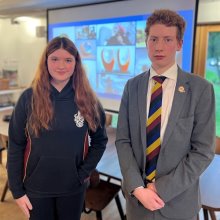
On Wednesday 19 October, Shiplake College’s Scholars gathered in Marjorie’s Café for another Masterclass talk. This time, co-chairs of the Exemplum Docet Society, Jamie King and Charlotte Garnett, delivered lectures to the rest of the scholars and members of the College community. Their presentations, on post-structuralism and Barbara Hepworth respectively, were delivered to a high standard, thus highlighting the duo’s pedigree as Shiplake Scholars.
First to present was Jamie King on his chosen topic of post-structuralism. A philosophical theory, post-structuralism is a term that builds on, and ultimately rejects, the ideas proposed by structuralists.
Jamie began his presentation by explaining to the audience the differences between the two theories. Structuralism, derived from the science of linguistics, proposes that language is an orderly system which is accurate and reliable. On the other hand, post-structuralism is derived from philosophy and proposes that language is a disorderly system, unreliable in its nature, with the aim of causing us to distrust the very notion of reason.
The concept of post-structuralism is tied to the unreliability of words, or signifiers. To demonstrate this, Jamie brought in Ferdinand de Saussure’s ‘Constructedness of Reality’ theory, where meaning is attributed to objects by the mind. In essence, words are random and arbitrary. A dog is a dog because it is not a cat or another type of animal.
Language touches everything that we know and this constructs our reality. Words, ideas, and even events, will have their own connotations. For example, an ongoing conflict between countries – is it a 'war' or a 'special military operation'; this would depend on an individual’s own perspective and how they would describe it. Thus, concepts have different connotations, and therefore can lead to different realities.
Jamie also posed the question about time. Since time runs without breaks, why are there four seasons? Why are there months? Why are there years? The post-structuralism theory is that there are no absolute truths. Since language is disordered and random, how can we trust anything? How do we know that gravity is a constant? How do we know that one and one will always equal two?
To some, this may be liberating as we, users of language, will essentially have free-play with words. But to others, the theory may cause ‘linguistic anxiety’ as the idea of nothing being certain, even though we may see it with our own eyes, may be difficult to grasp.
Jamie’s presentation, which is sure to be thought-provoking, drew in many questions from the audience. Quizzed on why he chose the topic, Jamie answered saying that he was intrigued by the theory when reading ahead of his university applications. And when asked on his stance on the post-structuralism, Jamie said that he found it to be one of the more radical theories within the field of philosophy.
In a slightly more different talk, Charlotte Garnett delivered a presentation on the life and work of Barbara Hepworth – one of the pioneers behind introducing negative space into art.
Heavily inspired by Barbara Hepworth’s work for her A-level and GCSE work, Charlotte was first introduced to her work through family in St Ives, at the Barbara Hepworth Museum and Sculpture Garden in addition to an exhibition in Wakefield.
Beginning with an overview of Barbara Hepworth’s history, Charlotte touched on Hepworth’s life of artwork, including the use of different materials in her sculptures, as well as how she inspired many artists particularly in the St Ives area. In 1949, Hepworth helped form the establishment of the Penwith Society of Artists, helping to attract international attention to the group’s exhibitions.
From 1949 until her death, Hepworth worked in Trewyn Studios, now known as the Barbara Hepworth Museum. On Trewyn studios, Hepworth said, 'Finding Trewyn Studio was a sort of magic. Here was a studio, a yard and garden where I could work in open air and space.'
Charlotte then presented to the audience one of Hepworth’s well-known pieces of artwork – Madonna and Child. Inspired by the death of her son, the impact of this tragic event led to her making this artwork as a memorial to him. Called so, it symbolises motherly love which is also linked to the love that she had for her son. Made out of marble, the artwork can be found in St Ives Parish Church.
Negative space is ultimately what Barbara Hepworth is renowned for and Charlotte concluded her presentation with an overview of the concept. Negative space in art is the empty space around and between the subject. It can be just as important as the object itself as negative space helps to define the boundaries of the positive space and brings balance to a composition.
Hepworth introduced negative space to art because sculpture had previously been thought to be an object that existed in space. Hepworth, on the other hand, was intrigued by the idea of creating space within an object and opening up the form.
Hepworth’s aim was to enable viewers to imagine themselves inside her sculptural forms. Hepworth often incorporated negative space into her sculptures where she explored interactions between the artwork, the person viewing the artwork, as well as the place where they were located.
Thank you to both Jamie and Charlotte for their engaging and enlightening presentations. To stand and present on such complex topics shows great character, as well as great knowledge of the topic. We look forward to the next Scholars’ Talk on Thursday 10 November, in which Jack Scanlon (Year 11) will discuss the ethical implications of trans athletes in sport, while Mr Sam Shaw will speak on the development of the modern suit.





















